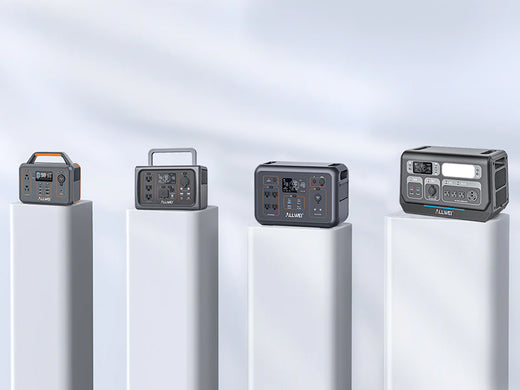Portable power station. Not only does it cater to your essential electronic devices, but it also provides reliable power support for an unexpected yet critical appliance: your refrigerator. Hence, it is important to know how many watts a refrigerator uses for many reasons. Suppose you live in an area that can be hit by harsh weather, and there is a chance of a power outage. Now, you need to know an estimate of power usage by appliances to arrange a power generator. Also, you should know the average power consumption to save on the power bill.
How many watts a refrigerator uses is a challenging question because power consumption depends on many factors, including the type of refrigerator, size, usage, and season. Generally, a domestic fridge consumes about 350-780 watts so let us go into the details.
Importantly, refrigerators generally have a much lower "running" wattage than their stated average wattage – this is because they cycle on and off throughout the day. As a general rule of thumb, you can divide your refrigerator's wattage by 3 to estimate its actual energy usage. So, a 500-watt refrigerator actually will use about 167 running watts.
The exact amount of power your refrigerator uses depends on how old it is and its make and model, but for the sake of this analysis, let's consider a side-by-side fridge/freezer. The two parts of your combo fridge/freezer appliance use similar amounts of electricity. However, freezers use more energy to produce cold air, and the amount of space they take up is usually less.
Over the course of a year, a fridge might cost about $235 to run – that's about $20 on each of your monthly electricity bills.
Your electricity usage and bill are measured in kilowatt-hours (kWh), a measurement of wattage over time. One kilowatt (kW) is 1,000 Watts (W), which means that powering a typical refrigerator for one day uses about 4 kWh of electricity.
As electricity bills are soaring, this is high time to analyze alternate energy sources that are cost-effective and more environment-friendly. Solar panels are a great option because they have no fuel cost after the initial investment.
How Many Watts Does A Refrigerator Use?
Top-Mount Freezer Refrigerator
These refrigerators have a freezer on top and a fresh food compartment on the bottom. They’re the most energy efficient type of fridges because of the location of the freezer and compressor.
The compressor is located at the bottom of the refrigerator, opposite where the freezer is. On a bottom freezer unit, the compressor is much closer. Therefore, it’s harder to keep the heat out.
Top freezers are furthest from the compressor, which means they use significantly less energy than bottom freezers, reducing power consumption.
On average, an Energy Star top-mount freezer refrigerator uses about 360 kWh to run.
Side-by-Side Refrigerator
Side-by-side refrigerators have two separate compartments, each with its own door. One side consists of the freezer compartment, and the other is the fresh food compartment.
An Energy Star side-by-side fridge uses about 630 kWh to run.
Mini Fridge
Mini-fridges require much less power than a full-sized kitchen refrigerator. While wattage is based on cooling capabilities, most appliances require somewhere between 50 and 100 watts of power.
You can find the exact power consumption details in the owner’s manual or with a quick Google search.
1. Definition of Amps, volts, watts, running watts, watt-hours
Watt is a unit of Power indicating the rate of energy transfer. In electric terms, it is the rate at which one ampere of current flows through one volt.
W= A* V
Volt or Voltage (V):
Volt is the energy measure running through an electric circuit.
Current – Ampere (A):
Current is the electricity flowing through the circuit per second. The more the current, the more the ampere.
Capacity – Watt-hour (Wh):
The capacity of a battery is Amps multiplied by voltage. It is the total amount of electricity generated due to electrochemical reactions in the battery.
Running watts are the continuous watts required to keep the electronic device running. It is also called rated watts.
Starting watts are extra watts required to start electrical devices, which are needed for a few seconds. This is the maximum watt measure required from the electric source.
2. How Many Watts Does A Mini Fridge, Freezer, and Refrigerator Use?
You can find the voltage and amperes on the sticker inside your refrigerator. We are using these numbers to calculate how many watts a refrigerator use. The formula to calculate the watts is to multiply the amperes with volts.
Watts = Volts * Amperes
The twist in the story here is that the wattage we have found is the energy your refrigerator uses when the compressor is working. However, the compressor is not always on. It turns on when the refrigerator is about to lose its cooling, then the compressor starts working to maintain the temperature and then goes off again. So, you get a smaller answer to your question “how many watts does a refrigerator use?”.
When we multiply the Watts by 24, you get the wattage for the whole day, and dividing the result by 1,000 converts it to KWh. Let us show you all the calculations by an example. Suppose your refrigerator runs at 120 Watts.
Multiply it by 24 to get the whole day's wattage, and it comes out to be 2,880 Watts.
However, the estimated running wattage of the refrigerator is around one-third of the actual wattage. Dividing 2,880 by 3, we get the answer of 960 watts.
Divide the result by 1,000 and it gives you 0.96 kWh.
How many watts does a refrigerator is not a constant because many factors contribute to power consumption, including:
- Location of the refrigerator as the ones placed in well-ventilated areas use less Power.
- If you open the fridge door frequently or left open, it will consume more watts.
- Seasons as refrigerators use more energy during summer.
- Technology also plays a role because inverter refrigerators may use less energy.
3. How Many Amps Does A Refrigerator Use
We have figured out how many watts a refrigerator is and will now calculate the ampere usage of the refrigerator.
Amps = Watts/Volts.
If your refrigerator uses 960 watts and 120 Volts then we can calculate that it will use eight amps (960 watts/120 volts).
Calculate How Much Energy Your Own Refrigerator Uses
The first step to finding out how many watts does a refrigerator start with identifying the wattage of your refrigerator. Usually, a sticker is placed on the inside wall of your fridge or sometimes at the back of the unit. You can also find the specification in the user manual of your appliance.
You will find the volts and amperes in the specification. Suppose your refrigerator runs on 120 Volts and 5 amperes.
Volts = 120
Amperes = 5
Watts = Volts * Amperes
Watts = 120 * 5
Watts = 600
Best Solar Generator for Refrigerator
The best solar generator for a refrigerator is the one that provides sufficient energy for your refrigerator, including the starting watts. The smooth running of the generator is also important. Secondly, good energy storage is also required to provide battery backup for the refrigerator after sunset when it cannot acquire direct solar energy.
Therefore, when we choose a solar generator to power a refrigerator, the power and capacity of the solar generator have become important reference indicators. For example, ALLWEI PPS1200-3 1200W and PPS2400-3 2400W solar generators have enough power and capacity to provide power support for your refrigerator during power outages.
ALLWEI PPS2400-3 2400W portable power station has 2400W output power and 2048Wh capacity, and has 11 output ports, which means it can also power other large equipment including refrigerators; PPS2400-3 portable power station supports AC 1400W, 500W Solar energy, 280W car charger and other charging methods can provide sufficient power supply for households during power outages.
ALLWEI PPS1200-3 1200W portable power station has 1200W output power and 1008 watt-hour capacity. It also has 13 output ports and can provide power for refrigerators, TVs, coffee machines, computers and other devices. It supports AC/DC/solar energy, etc. Multiple charging modes to provide power support for your outdoor travel and home.

![How Many Watts Does a Refrigerator Use? [and Mini-Fridge, Freezer]](http://www.allweipower.com/cdn/shop/articles/11111_520x500_520x500_26e93bbf-508f-483b-84a5-c0edddd02901.jpg?v=1734603239&width=1500)




Leave a comment
This site is protected by hCaptcha and the hCaptcha Privacy Policy and Terms of Service apply.